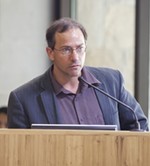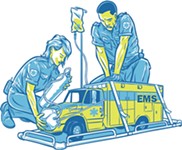A Healthier Workforce
EMS chief proposes to reduce medic work week
By Chase Hoffberger, Fri., Sept. 4, 2015
The sky began to fall before the third weekend in June. That Friday, June 19, word got out from city management that Travis County Medical Director Dr. Paul Hinchey would soon resign from his position. The resignation (he's headed to the private sector) – effective Sept. 2 – marked the first significant culture and policy shift since two suicides and a third fatigue-related death changed the state of Austin-Travis County Emergency Medical Services from "troubled" to "life-threatening." Paramedics contacted by the Chronicle throughout the spring and summer months spoke of Hinchey's heavy-handed management methods and insistence on deploying an ambulance staffing model that they said compromised quality of patient care (not to mention the medics' morale and energy) to fix a city staffing issue (see "High Stress at EMS," May 8).
That same week, City Council member and Public Safety Committee Chair Don Zimmerman ruffled ATCEMS' administrative feathers a little more when he amended the following Monday's PSC meeting agenda to include a discussion about a possible merger with the Fire Department. The proposition – a longstanding idea that's been intermittently proposed since ATCEMS' inception in the Seventies – was strictly preliminary, and received an unequivocal "we're not considering it" from Asst. City Manager Rey Arellano during early 2015-16 budget discussions. However, Zimmerman's insistence on broaching the issue did help reignite questions concerning whether or not ATCEMS is doing the best job managing resources, and whether or not department Chief Ernie Rodriguez and his executive staff are capable of managing a team of roughly 400 medics, commanders, and captains.
The state of ATCEMS's field staff – an overworked crew that, in addition to managing the stress that comes with responding to life-or-death emergencies all day, must work mandatory overtime shifts to augment their 48-hour work weeks and are often called in for additional last-minute overtime shifts to keep ambulances operating at capacity – has come back into question over the past month as City Council tries to sort out next year's budget. Rodriguez and his executive staff have been asked not just what they need, but how they plan to use their resources for the betterment of their workers. The chief was pressed multiple times during the Aug. 12 budget hearing before Council, most notably by Mayor Steve Adler. Then, Rodriguez chalked morale issues up to a changing Austin landscape; one that's seen its population increase 29% since 2005.
"That increase has resulted in a 50 percent increase in the number of EMS incidents that we're experiencing in our community," he said. "And that's increased our transport by 61 percent."
Indeed, city metrics show that ATCEMS eclipsed the 10,000-incident figure for the first month ever this July. Tack that onto a city that's now hosting a seemingly impossible amount of special events (remember, UT football's coming up, along with Formula One and a string of races and festivals), and you're creating a serious strain on resources. Rodriguez's proposed budget for FY 2016 includes funding for 12 new sworn positions and an ambulance, both of which will be used to address a service gap near Loop 360.
At the top of the chief's wish list, however, though not part of city management's proposed budget, is a reduction in medic work weeks. Standard schedules currently call for field staff to work 48 hours a week. ATCEMS transitioned from 56 hours per week in 2006, then shifted its communications staff from 48 to 42 in 2011, and reduced field commander schedules down to 42 hours in 2014-15. Rodriguez would like to cut field staff to 42 hours as well, starting with captains this year, adding 15 FTEs to the pool at a cost of $1.3 million, and then follow up with 52 new medics next year – 2016-17 – for an additional $5 million. The proposal, he says, would "reduce contact time" for medics and "produce a healthier workforce." More time off the clock means more time on the mend. (The plan is currently under consideration as part of the 2015-16 Concept Menu, after a proposal from CM Delia Garza. Zimmerman, ever the heel, suggested cutting APD's budget to account for a shift at ATCEMS.)
Austin-Travis County Emergency Medical Services Employee Association President Tony Marquardt doesn't see eye-to-eye with Rodriguez's optimism. In fact, he believes a shift in scheduling will bring no immediate change to the workforce's many troubles. He points to a chronic issue of medic departures (at least 34 separations in each of the past four fiscal years) and wonders how a budget that lets ATCEMS hire new medics (as well as a fourth chaplain) will help a field staff that's constantly losing workers. A 42-hour work week is only a 42-hour work week if the department is staffed with enough medics to allow its field staff to work that short of a schedule (without mandating that they perform overtime). "We'll do the same amount of work we've always done," said Marquardt. "The challenge is going to be year two. There's no guarantee, even if Council moves forward on the two-year plan, that we won't face these challenges again."
Medics were forced to compensate for 33 acknowledged vacancies in April, as well an additional 30 positions currently being occupied by cadets in training who weren't yet permitted to work an ambulance. Whether those cadets ever materialize into long-serving medics remains to be seen, but at the rate cadets are graduating, it's likely that they'll be used to patch new vacancies created by separating medics, rather than newly created positions.
"It's astounding what they're doing," said Marquardt of ATCEMS leadership. "They seem to be resigned to the idea that they're always going to be reacting to a short-staffed situation .... It's really disappointing to be in this mode where unmet needs are ambulances, stations, and medics. If we're going to have an unmet needs conversation, that should be about whether we need a chaplain or not, or whether or not we should do a fatigue study to determine whether we're tired."
One paramedic who asked he not be named took the perspective even further. "You're chasing your tail," he summarized. "You're treading water, if that. And the other assumption is that of the 42 [new FTEs] you hired, you're going to keep 42 of them. None of them will wash out? If that becomes the case, either a) you've found the golden well where perfect employees are located, or b) you've lowered your standard.
"They're not ad-dressing the real problem: the workload. If you look holistically at the things that we respond to, a lot of times it's cases in which there's no confirmed patient. For collisions, we send one ambulance and two fire trucks [before it's clear that an ambulance is needed]. They need someone to come in and redefine what they're supposed to do. When you have all that sorted out, you can say, 'Okay, why do we have a retention problem?' Until you fix that, the problems aren't going to go away."
Marquardt suggested at the most recent PSC meeting, Aug. 24, that the change in medical direction may help alleviate some problems. He's long pointed to separation figures to show the number jumping significantly when Hinchey came in, and he remains optimistic that new blood in the medical director's office may help keep medics around. But getting them to see things in a different light may prove difficult, as it's often hard to believe in change when you're overworked and under-slept.
Editor's note: An earlier version of this story contained the sentences, "Austin-Travis County Emergency Medical Services Employee Association President Tony Marquardt doesn't see eye-to-eye with Rodriguez's optimism. In fact, he believes a shift in scheduling will in actuality bring no change whatsoever." After Marquardt contacted the writer and posted a comment (see below) explaining that the second sentence was not an accurate reflection of his opinion, it was changed to read, "In fact, he believes a shift in scheduling will bring no immediate change to the workforce's many troubles."
Got something to say on the subject? Send a letter to the editor.











